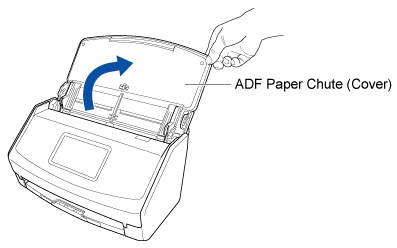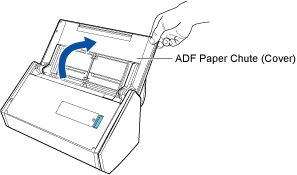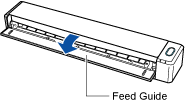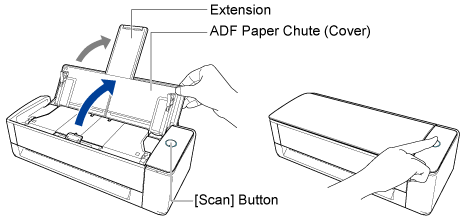Multiple ScanSnap units can be added to one computer. Switch to a ScanSnap unit to be connected which you selected from those added to the computer in ScanSnap Home. For example, you can connect a ScanSnap unit in your office and another one at home to a single computer, and easily switch between them.
When doing so, using ScanSnap Cloud allows you to use the profile with the same settings on either of the ScanSnap units.
For regions where ScanSnap Cloud can be used, refer to here.

It is assumed in the following explanation that ScanSnap Home is installed on a computer to be connected to the ScanSnap. If not, install ScanSnap Home from here.
- Connect the ScanSnap to a wireless access point.
-
Open the ADF paper chute (cover) of the ScanSnap to turn the power on.
- Press
 in the home screen on the touch panel of the ScanSnap to display the [Settings] screen.
in the home screen on the touch panel of the ScanSnap to display the [Settings] screen.
- Press
 to display the [Wi-Fi settings] screen.
to display the [Wi-Fi settings] screen.
- Press [Wi-Fi connect mode] to display the [Wi-Fi connect mode] screen.
- Select [Access point connection].
- Press
 to return to the [Wi-Fi settings] screen.
to return to the [Wi-Fi settings] screen.
- Press
 to return to the [Wi-Fi settings] screen.
to return to the [Wi-Fi settings] screen.
- Press [Access point connection] to display the [Access point connection] screen.
- Press [Access point connect settings] to display the [Connection information configuration method] screen.
- Select [Select an access point].
- Press the [Next] button to display the [Select network] screen.
- From the list of displayed wireless access points, select a wireless access point that you want to connect to.
- Press the [Next] button to display the [Enter connection information] screen.
- Enter the information of the wireless access point to be used and press the [Next] button.
The items which are displayed in the screen differ depending on the security protocol of the wireless access point.
- Press the [Complete] button in the [Check Connection Results] screen.
- Press
 to display the home screen.
to display the home screen.
- Check the scanner name of the ScanSnap to be connected.
- Press
 in the home screen on the touch panel of the ScanSnap to display the [Settings] screen.
in the home screen on the touch panel of the ScanSnap to display the [Settings] screen.
- Press
 to display the [Connecting Devices] screen.
to display the [Connecting Devices] screen.
- Check the scanner name that is displayed in [Scanner name].
- Add the ScanSnap that you want to use to ScanSnap Home.
-
Click the [Scan] button at the top of the Main Window of ScanSnap Home to display the Scan Window.
- Select [Add a ScanSnap] from the [Select a scanner] list.
- In the [ScanSnap Home - Connecting ScanSnap] window, select the ScanSnap model to be added and then click the [Start setup] button.
- In the [ScanSnap Home - Connecting ScanSnap] window (Connection with the ScanSnap), select the scanner name of the ScanSnap to be added, and click the [Next] button.
TIP
-
When an IP address is set for the ScanSnap, you can add the ScanSnap to ScanSnap Home by specifying the IP address.
Specify the IP address for the ScanSnap to be added in the window that appears when you click [Using an IP address].
- When the [ScanSnap Home - Connecting ScanSnap] window (Connection is complete) appears, click the [Next] button.
- When the [ScanSnap Home - Connecting ScanSnap] window (Let's use it!) appears, check the contents and click the [Close] button.
- Add all the ScanSnap units that you want to use to ScanSnap Home.
Repeat step 3 to add all the ScanSnap units that you want to use to ScanSnap Home.
To use a ScanSnap unit that you added, select the scanner name of the ScanSnap from the [Select a scanner] list in the scan window.
-
Connect the supplied USB cable to the USB connector on the ScanSnap and the USB port on the computer.
-
Open the ADF paper chute (cover) of the ScanSnap to turn the power on.
-
Open the feed guide of the ScanSnap to turn the power on.
-
Hold the right side of the ADF paper chute (cover) of the ScanSnap then open it or press the [Scan] button to turn it on.
Open the ADF paper chute (cover) fully so that the [Scan] button lights up in blue.
When the ADF paper chute (cover) is opened, the extension will rise automatically.
-
Click the [Scan] button at the top of the Main Window of ScanSnap Home to display the Scan Window.
-
Select [Add a ScanSnap] from the [Select a scanner] list.
-
In the [ScanSnap Home - Connecting ScanSnap] window, select the ScanSnap model to be added and then click the [Start setup] button.
-
In the [ScanSnap Home - Connecting ScanSnap] window (How to connect ScanSnap), click the [Next] button.
-
When the [ScanSnap Home - Connecting ScanSnap] window (The ScanSnap has been connected successfully.) appears, click the [Finish] button.
-
When the [ScanSnap wireless network setup] window appears, click the [Setup now] button to display the wireless network setup wizard.
Follow the instructions on the window to connect the ScanSnap to a wireless access point.
-
When the [ScanSnap Home - Connecting ScanSnap] window (Let's use it!) appears, check the contents and click the [Close] button.
-
Add all the ScanSnap units that you want to use to ScanSnap Home.
Repeat the procedure from step 1 to 9 to add all the ScanSnap units that you want to use to ScanSnap Home.
To use a ScanSnap that you added, select the scanner name of the ScanSnap from the [Select a scanner] list in the scan window.
Multiple ScanSnap units can be used with one computer by switching the connection. [Scan to Cloud] which is the default profile, and a profile that you added by selecting [Scan to Cloud] which is the template profile can be used with all the ScanSnap units that are added to ScanSnap Home.




